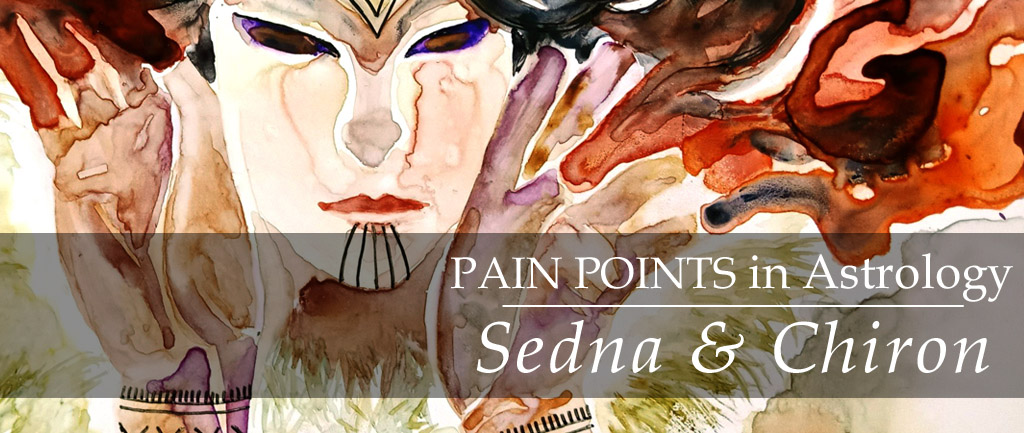
Chiron is one of the better known asteroids in astrology, often referred to as the “wounded healer”. Found and named in 1977, Chiron is one of the Centaur asteroids that doesn’t stay in a neat orbit, but travels an eccentric path that cuts through the orbits of Saturn and Uranus. The centaur asteroids all have eccentric paths among the outer planets to Saturn/Uranus.
Chiron’s path looks like this, its aphelion in Aries; perihelion usually in Libra:
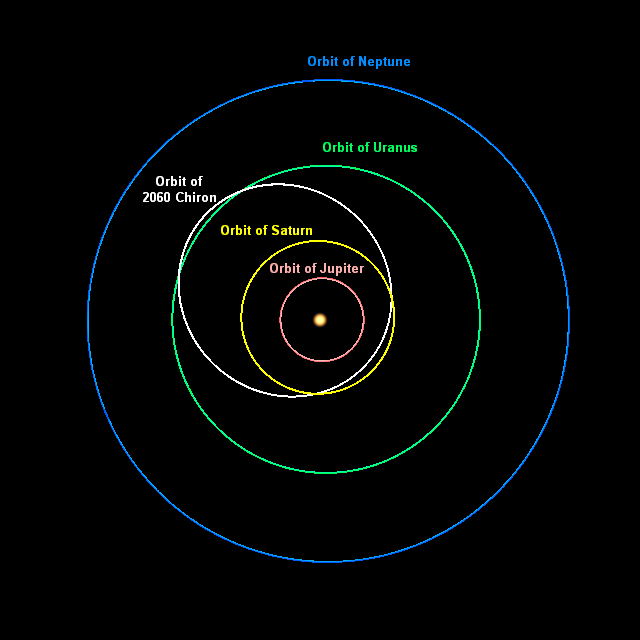
As the wounded healer, Chiron’s wound was in one of his hooves. It was an unintended injury from one of Hercules’ arrows that had been tipped with blood of the Hydra. This painful injury from the “first biological weapon” known in Greek mythology was something the famous healer and trainer of heroes could never heal for himself.
In a birth chart, Chiron almost always reveals an individual’s physical or psychic wound–when conjunct natal sun or in the first house, life-threatening physical circumstances may have been experienced by such a native since an early age; Chiron aspects to moon or in the water houses (4th, 8th, 12th) tend to point to enduring psychological wounds.
But I’d like to give more time to Sedna here, since there’s already a lot of material out there on Chiron.
Sedna the Asteroid
Sedna’s orbit is THIS far out:

With this orbit, it’s remarkable that Sedna was noticed at all, but it does hold the distinction of being the first known member of the Oort Cloud, which previously had been a theoretical spherical shell (proposed by Jan Oort) of icy objects far beyond our solar system. It was noticed and archived beginning in 2001, so the orbit and ephemeris positions of Sedna from before 2001 were done by calculation. Its orbital period is estimated at 11,400 years.
Sedna will be closest to us in 2076, when it’ll be 76 AU away (1 Astronomic Unit = the distance between sun and earth). Its aphelion is at 937 AU. In contrast Chiron’s aphelion is 18.865 AU. (The Forbes link under the image goes to an article advocating the use of Sedna’s orbit and perihelion for research.)
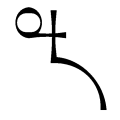
Mike Brown, one of the discovers of Sedna, has plenty of information related to Sedna and the process of observing and drawing conclusions about it here.
If Pluto had been named for the Greek/Roman mythological ruler of the Underworld because of it was the farthest known (dwarf) planet from the sun at that time (30 AU at its closest to the sun), then Sedna inhabits deep hellish spaces farther beyond. The name Sedna is from Inuit mythology; She is a goddess of the sea and the Inuit underworld.
It’s been observed that the asteroid is unusually red. Which is a good point from which to look at the mythology of Sedna.
Mother of the Deep, Ruler of Adlivun
Owing to the oral traditions of the diverse Inuit, many versions of Sedna’s story exist. But they all have a gruesome ending: Sedna’s murder at sea by her father, whereupon she sinks to the bottom of the arctic sea. There she becomes goddess, and her hacked off digits or limbs become seals, walruses, and whales.
These are the common story elements:
- Sedna is a rebellious daughter who rejects suitors and refuses to marry
- In one version, to spite her father, she marries a dog and has a family with the dog, which further pisses off Dad. In some other versions, the dog marriage is actually her parents’ punishment, but it’s a happy marriage for Sedna
- In a different common version, Sedna marries an attractive stranger, who promises furs, blubber, and a life of comfort. But he lives on a faraway island and is actually a magical bird in disguise. Birdman spouse can only give her fish. Sedna becomes miserable and wails
- All versions have Sedna’s father putting Sedna in his boat. In the dog marriage version, it’s to punish Sedna (again) and take her out of the dog marriage. In the birdman marriage versions, it’s to rescue Sedna and bring her home. In the rescue, there is usually a chase by the birdman and/or his minions. This chase is complicated by a ferocious storm at sea, putting the boat in jeopardy
- Sedna’s father chucks her overboard to save himself, but Sedna clings onto the side of the boat. Motivated by anger or self-preservation, her father hacks off her fingers and thumbs. In one version, it’s her fingers and arms
- Sedna sinks to the bottom of the arctic sea and makes it her home. She has dominion over all the sea creatures, controlling the success and failure of Inuit hunting trips. When food becomes scarce, shamans have to descend into her world to appease her and help untangle her hair (it’s tough to comb without fingers).
- As ruler of the underworld, she judges all the souls of the dead who pass through her domain. Adlivun is more a purgatory and not the final destination; souls eventually move on to Qudlivun, a place “above us”.
Sedna: Power and Abuse
Sedna’s story immediately captivates especially in any culture where it is the expectation and norm for daughters to be married, or else stay home and serve their family/parents. Today, gender and financial equality and independence for women can still be taboo, but couched in religion, or tradition, or emotional blackmail/enmeshment.
Taboos (and control) are unfortunately made more powerful by shame. In the dog marriage, Sedna subverts her father’s shaming by being happy in her unusual marriage.
In the birdman versions, there is implied shaming that she was a picky brat who fell for the birdman’s ruse and promises. (Honestly, it’s damned if you do and damned if you don’t–we don’t know if other suitors would have worked out either. This shaming is echoed by other writers–links under “Further Reading”–and linked with Sedna’s vanity. I’m reluctant to follow this view as it’s not clear from the different readings if Sedna had thought herself “too good” for her suitors. I’m also not in the camp that supports women “settling” for someone just because she “must” be married. Yeeucch.)
The loss of her fingers is damaging multiple times: A woman’s worth and contribution to the home in Inuit culture is in her crafting of food and clothing. The hair-combing appeasement by shamans underlines how she lacks fingers to tend her appearance (for her benefit or for ours?), and her dependence on her father for safe passage is also betrayed by their severance. (This page on Inuit women’s roles and duties is frustrating when describing how men and women were treated as equals–yet women had no power in community decisions, or in her marriage or reproductive choices. But ignore me and go on about equality.)
Sedna’s apotheosis was not the result of any agency given her, but the side effect of an attempted (and successful) murder. It seems fitting that Sedna can be a rallying mythological figure for raising awareness of inequality, misogyny, abuse, DV, even human trafficking, though others have also shied away from “negative” readings of the indigenous story. As a POC–though I do not speak for all–I think misogyny and abuse cannot be culturally defended, so I don’t think Sedna’s story should be sugarcoated as in the examples explored here. I do think all stories, gory as some may be, should be explored for what meanings they can hold for the evolution of all those who relate strongly to specific ones.
In other words, this is my sense-making exercise with Sedna.
Let’s get into the wounding more deeply.
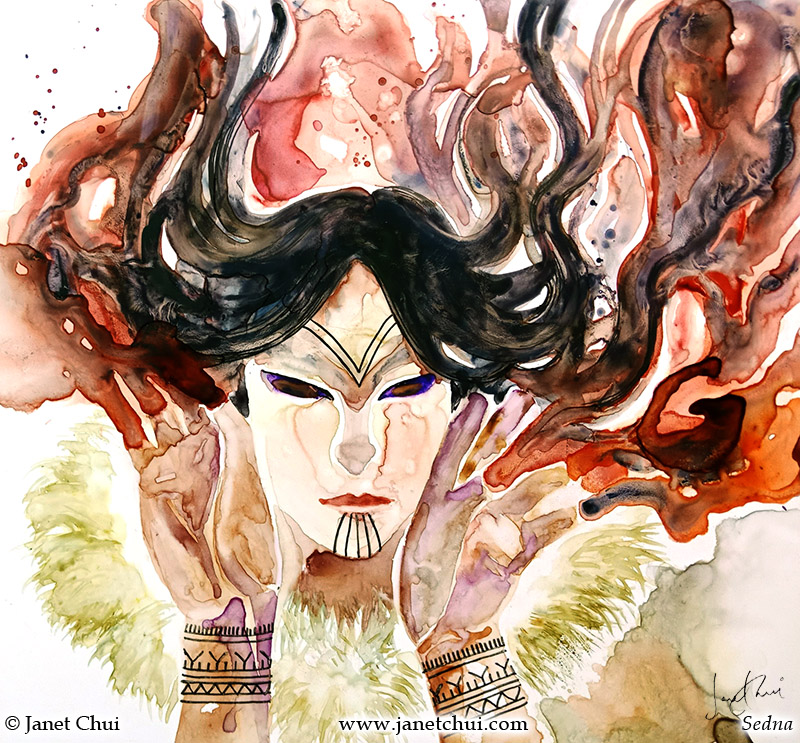
Sedna conjunct Chiron
Sedna’s orbital period: 11,400 years
Chiron’s orbital period: 50 years
Previous Sedna-Chiron conjunction: 1977-1978, in Taurus
Next Sedna-Chiron conjunction: 2035, in Gemini
I got curious about Sedna when viewing my birth chart “fully loaded” with my software’s asteroid ephemeris. Sedna was 0 degrees 24 minutes from my natal Chiron, which I’ve always been a tad sore about, positioned as it is 3 degrees from my IC in the 4th house. The IC or Imum Coeli is one of the angles and most sensitive points on a birth chart because it pertains to one’s roots, beginnings, and home.
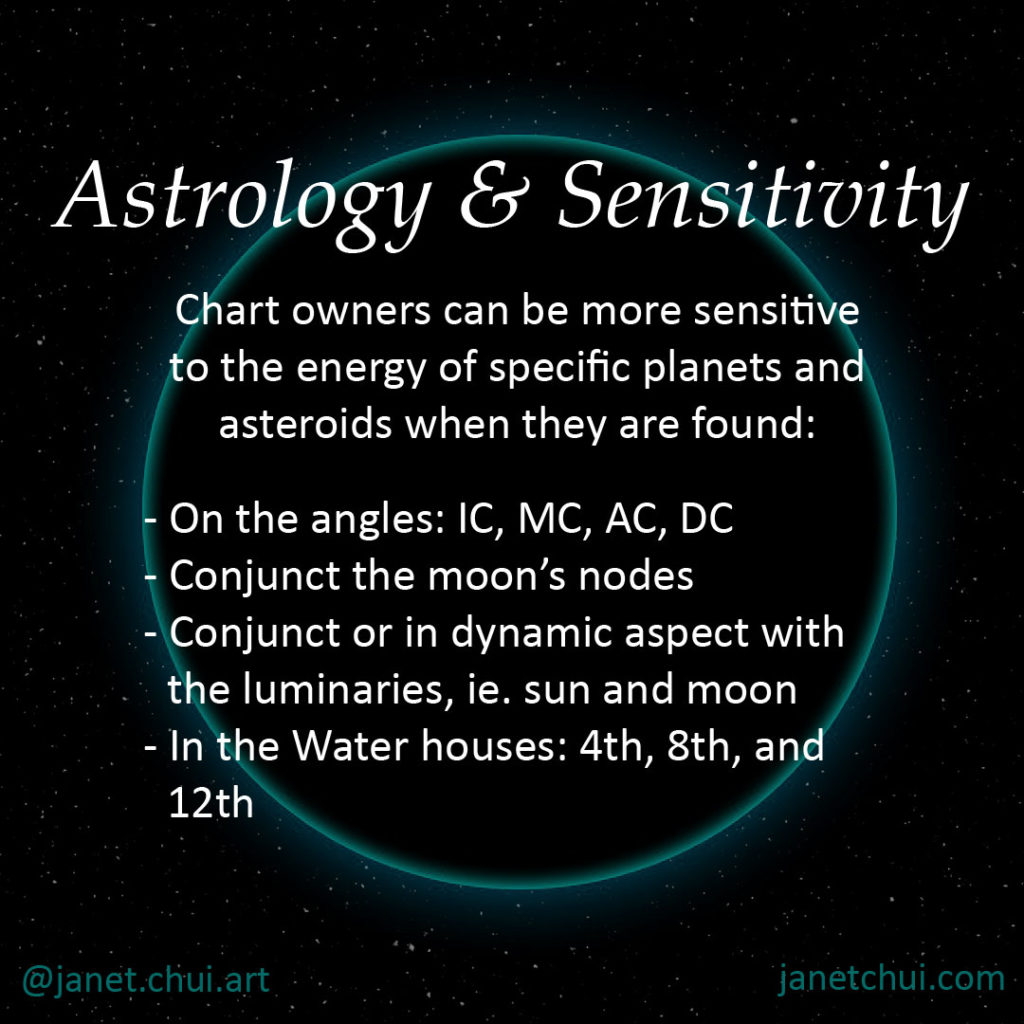
Other ways planets/asteroids get prominent: Being the “handle” of a bucket formation, the edge of a bowl, tip of a yod, number of aspects made to personal planets, the lone body activating an element, etc.
Having an activated, sensitized or prominent Chiron never feels like a gift for the chart owner. Pain is the gift, which few appreciate unless they’re masochistic. Chiron is one of the things I look at to find chronic health issues, or someone’s psychological Achilles’ Heel, or in some cases, the marker for a physical deformity or genetic quirk.
Chiron in Taurus or the second house can manifest as wounded self-worth and/or means of earning.
Chiron in Cancer or the fourth house can manifest as a lack of nurturing and emotional security at home. Wounded roots and beginnings (particularly in the 4th house). Tom Jacobs specifies that individuals with 4th house Chiron as likely to go through emotional disconnect (or outright rejection) by parents or family.
This sounds like Sedna’s story. And I’ve had to grapple with how her placement in my chart is as prominent as Chiron, though she isn’t as well known. I hope this writing helps anyone with prominent Sedna.
In 1977-1978, Sedna and Chiron danced together in the sign of Taurus (note: Sidereal position Aries). They both went through retrogrades in that time, prolonging their proximity. Conjunctions in astrology are the merging of two energies. Sedna with Chiron “ups the ante” on the control, victimisation, abandonment, and betrayal themes around family and gender roles, particularly the roles of women.
Grooming for Abuse: Toxic Masculinity and Rape Culture
I’ve always been sensitive to the unequal treatment of girls, born into the culture and environment that I was. In Chinese/disapora culture, male children are valued and treated differently, having greater potential (earnings-wise, and providing kids that continue the family surname). I would hear that girls were not as worth investing in–their role was in helping with childcare and housework. Most authority figures I knew, including older women with internalised misogyny, worked together to put girls into their subservient roles. The motto of my girls’ school was “Demure & Resolute”.
((((JANET TRIGGERED Demure” can go take a fucking hike. Who TF benefits from anyone being “demure”? It is a trite expectation from anyone, much less a value to aspire to.))))
Besides being worth less–phrasing fully intended—daughters have always been controlled more. Limits are enforced upon her every day, physically, emotionally, mentally, psychologically, psychically, sexually, spiritually. Her role and chastity is defined in religious texts and rules. She is told how to feel, yet called overemotional and irrational. Then she is told to cut herself off from her feelings, to diminish herself, or be ashamed or who/what she is. She is often too thin or too fat, too buxom or too flat, too inarticulate or too loud, too soft or too hard. There are hundreds of flaws to point out in her that are rarely a problem in her male counterpart, likely because males are seen as people first, while women are still frequently seen as objects.
Be quiet, pretty, and useful; will you, dear?
In many cultures, women and daughters still are expected to make other people happy. Rarely is agency accorded, or permission granted to put her own priorities first. It isn’t just Asian culture–any authoritarian culture and quite a few organised religions do this. Read any (conservative) comment thread about a female public figure to see how many insult her looks or put her husband’s happiness above her accomplishments.
Grooming for abuse happens when people are expected to stay in their boxes. Venture outside, and punishment is due.
Sedna was expected to just pick any damn suitor and like it. When she refused, the dog marriage was supposed to punish her, but the punishment failed. Sedna was happy in all dog marriage versions of her story. Dogs in many cultures (including Inuit) are known as affectionate and loyal creatures. These qualities can be held up in opposition to the punitive and faithless behavior of Sedna’s father.
In the birdman stories, it can be pointed out that Dad had no objections to this suitor, who to all appearances ticked all the boxes: Rich, handsome, available. So I differ again from other analyses that paint Sedna as vain/superficial/greedy. If we’re going to examine misogyny and systems which do not afford women autonomy, equality, and independence, we need to bloody recognise that Birdman looked like a hot catch. So off Sedna went with him, but Sedna was deceived. We shouldn’t forget that her father was too.
Father gets some credit for trying to rescue Sedna, but this also makes his final violence more tragic. The rescue of Sedna swings 180 degrees to her murder by whim of her father when the storm arrives.
In modern parlance, dude can’t deal and offs his offspring when shit happens.
Again: If you’re going to keep an imbalanced system in which daughters are burdens because they are not their own persons (they can only expect to be married and to serve as part of a marriage/family unit), these same not-their-own-persons become the responsibility of their “owners”. If this sounds alarming because of the potential abuse, the tragic beauty of Sedna’s story is that it also goes there.
For me and I suspect for others, rape has always been about “taking” without consent. Sedna’s fingers and life were taken from her. Stories sometimes tackle difficult subjects with symbols, which is why I feel rape culture is relevant here.
Rape culture refers to any implicit or explicit reinforcement of the idea that rape victims are responsible for their own rape. Part of grooming for abuse and control, rape culture hides in “logical” statements like: “If you _________, you deserve to be raped”. So women are again dealing with restrictions on their autonomy: Cover up. Stay home. Have a buddy or chaperone. Do whatever your partner or father asks. Don’t make him angry. Don’t inconvenience him. Don’t be picky. Don’t get uppity.
Don’t hang onto the side of his boat in a storm.
Storms are emotional overwhelm in the language of stories; and it seems that women and daughters are often punished when male family members or intimate partners lack self-regulation. This is consistent with domestic violence and femicide statistics; Women are convenient scapegoats and targets when men lose control. There’s no end of men who go violent when “their” women defy them. This lack of control can also be symbolic: That men frequently, due to toxic masculinity, lack coping and/or processing mechanisms for overwhelming “feminine” emotions, and only know how to express anger/violence to cover “worse” ones like guilt, shame, fear, helplessness, and grief.
There’s so much that can be traced back to the rigid expectations and the tragic burdens of Sedna’s female status.
For personal symbolism, the story of Sedna may echo how our inner bully/authority may be so afraid of one’s inner, vulnerable feminine rebel that it can easily choose to sacrifice the latter rather than integrate it and defy societal gender norms.
Hypermasculine, disordered and/or traumatised individuals can display overwhelming anxiety at acknowledging their vulnerability and carrying out emotional work. The fear and determination to avoid discomfort is more destructive than the storm of grief or shame or guilt.
Maybe we need reminders that all storms pass.

Nurturing and Judgment
Sedna’s severed digits/limbs become the warm-blooded, playful and intelligent creatures of the sea–but ultimately, food for the Inuit. Her “creator goddess” is a little bittersweet; Once her fingers are severed, she cannot direct her own creativity or what purpose to which they are used.
In modern human history, men’s contributions to art, science and literature happened on the backs of women who were frequently denied education and relegated, really, to domestic work. Feminine crafts such as cooking and the textile arts were inferior despite their obvious usefulness–or perhaps they didn’t get highfalutin recognition because it wasn’t art for art’s sake. (Once again, damned if you do, damned if you don’t. Women have no technical inferiority in producing great art or literature when given the chance, but we know a few still choose for strategic reasons to use male or gender-neutral names.)
So the creatures created from Sedna’s body are valuable to the Inuit as food and clothing. Sedna as goddess has the power to withhold this bounty from hunters. This withholding says, “If you do not care for me, I’ll let you starve.” This warning fits many different unbalanced relationships (perhaps all of them): Between Man and the environment, “breadwinner” and “homemaker”; between one’s masculine and feminine aspects, maybe even one’s inner authority and creative inner child.
Sedna is also the “vengeful goddess” of the afterlife. Not just a psychopomp, she controls the passage of the soul. Female psychopomp/underworld figures aren’t that many in mythology. Ma’at comes closest; she provides the ostrich feather against which a deceased person’s heart is weighed and judged by Osiris. Having a “light heart” (as opposed to a heavy one) lets the soul pass.
This symbolic relationship between passage and “dead weight” is richly loaded (geddit). Chiron’s burden in his life was his painful wound. Nessus (another centaur asteroid explicitly connected with safe/unsafe passage, another topic for another post) leveraged his human burden to exact spite. Different mythologies offer different ways to bear our crosses.
Application and Conclusion
So how does one lighten a heavy heart?
It cannot be done by cutting off one’s feelings and self-numbing. It cannot be done (effectively or compassionately) by killing off one’s inner child and vulnerable self. No matter how much we want to deny pain, we all need to do the shamanic work of sitting with it and soothing it with care, attention, and understanding. Self-care includes tending our emotional self. This work of self-nurturing renews the energies that sustain us.
Neglect this, and we may find that “moving on” eludes us in death too.
Sedna in the chart is vulnerable victim, rebel and giver of playful life; judge, and psychopomp.
I’ll leave readers with this last piece:
References & Further Reading
- Sedna: Astrological Meaning (Richard Brown)
- Feminine Astrology: Sedna Goddess in Exile
- Exploring the Story of Sedna
- Abuse is Ancient
- Sedna. (Narcissistic injury and healing: an Inuit version of Abraham’s sacrifice.)
Notes about this link: Interesting read, though I had trouble seeing Sedna’s refusal to marry as a narcissistic injury. If anyone showed it, the father’s narcissistic rage at the dog marriage fits, especially since narcissism focuses on how things look (“Imma be embarrassed I can’t get my kid married normally,” something familiar to all Asians with boomer parents). But this is a Jungian take and I don’t have Jung qualifications, so - Rape Perpetration: A Review
- Men, Masculinities, and Changing Power

I drew a picture that deeply resonates with the sedna story and haunts me so much
Best I read on sedna! She is conjuncting my chiron in transit and your text us absolutely remarkable!
Beautiful..
Thank you
I’m sedna conjunct chiron in the 10th house under Gemini. Thanks for this article, it’s really opened my eyes
I just discovered that transiting Sedna is now exactly conjunct my sun, and that all my life Sedna must have been a massive impression on my being (I have Taurus on the ascendant along with Jupiter, south node and Venus).
For many years I felt as though I existed deep under water and that it was profoundly difficult to try and connect with others who are basically living on the surface of the water, or out of it. I am deeply touched by what your writing has helped me understand…. A few years ago I had a very healing dream in which I was at a swimming pool, sitting awkwardly on the side, watching others playing around in the water, feeling so disconnected and awkward. The suddenly I dove off the side deep down into the pool that became oceanic and was so ecstatic, discovering I could breathe under water… a dolphin came, blessing me and I felt communion with my source of Being…. Now I have another level of understanding about this dream, that Sedna is alive in me.
Thank you for this writings, it helped me a lot to crystalize my Chiron conjunct Sedna (5 Taurus) pearls of wisdom into consciousness. It was easy epiphany while reading your article. It is deep, liberating, hard and easy at the same time. Blessings
Okay, I’m just learning of this beauty. With Chiron conjunct mars in a harsh locale of Taurus, in my 4th house, I was looking into this next full moon conjunct my natal Pluto, and I expand. This lovely little rebel warrior is conjunct my Ic/mc: while I’m routing though the 18 degree opposition of Uranus, infirther understand my beautiful pain even more so, today. Wow. Thank you for this in-site. I will not forget, as she will move to my sun sign next. Be and stay blessed
Wow… I so relate and see this in my own life played out. Thank you for taking the time to share your thoughts on this. I have both Sedna & Chiron in Taurus, 4th house, like you. I also have Chariklo in Taurus… The wounded feminine in me sees you and extends a hug…
Thank you so much! Glad to hear from anyone who has found this helpful. You remind me that I need to take a closer look at my Chariklo :)
Thank you Janet!
Wow… I just discovered about this asteroid. Mine is in retrograde, 2nd house in Taurus. It’s opposite with my Scorpio sun and mars…. (They are both in 8H and 15 degree—combust). Very interesting!
This brings so much light to the traumas of my childhood. I have Sedna and Eros directly on my on Ascendent, with Venus tightly conjunct. The sexual trauma and healing are potent in this contact point.
Beautiful article, I’ve got Sedna en Taurus 2H doing both semi-quadrate to Pisces North Node in my 1H, and to my Chiron in Gemini in the 4H. Also, straight opposition to Pluto in Scorpio. As you may figure, my Chiron is opposed to Saturn-Uranus Conjunction (first days of January 1988), and i’ve read A LOT about all of it. I’ve learned to rest and feel and accept mistakes as part of diversity in my home (Chiron), and value and money is the pendant theme to solve, as it lacks in a way that it feels unfair, but acting up on it. thanks colleague, inspiring article.
Wow thank you for this. There’s definitely a Sedna story in my life- it’s conjunct my Chiron in 7th house and it’s definitely playing out right now- not with my father but my brother …mind blowing parallels for me
I wrote a comparative article with Sedna and some of the other Indigenous and Slavic Maidens who didn’t want to get married, and shame and bad luck fell upon the family. To me it was a record of the destruction of women in the patriarch.
Just checked out your website and am so intriqued! I can see myself spending some time reading it. Thank you for your comment and for sharing your work!
How can I find Sedna in my chart?
This is such a brilliant interpretation of Sedna, thank you!
I am in awe of your descriptions and analyses of Sedna; I have looked at Sedna many times but the depth( no pun intended) of meaning you have explained, is extraordinary.
In my natal chart Sedna is opposition the sun ,square moon, bi-quintile Jupiter, trine Saturn, square Vesta ,Haumea, and Makemake.
Well that explains a lot. I have Sedna and Chiron conjunct my Sun in the 12H square my Jupiter at my IC. Transiting Pluto is at my MC creating a TSquare.
Thank you for this wonderful piece! I just discovered that I have Sedna exactly conjunct my ascendant by one arc minute in Taurus, which also conjuncts my Chiron by 1° and Venus/Mars by 3°. I can’t say I’ve had anything similar happen to me literally in my life, thankfully, but definitely symbolically. I have been a victim of sexual violence (shocker), and I find that I am particularly drawn to helping educate people on the importance of understanding the nuance in victims experiences of sexual violence.
Thank you for this. I too have Chiron Sedna conjunct the IC- so good reading your article to get some insight and also reading the comments- that I’m not alone in this – this is woman’s story and the resilience that women are still creators even if they’re sunk hidden under the waters. I find parallels of Sedna having her hands cut off to so many of the statues of the goddesses of the ancient world who had their arms and hands hacked off – their power to act in the world taken from them.
Cannot thank you enough for this article&resources. I have Sun in a tight conjunction with Chiron and Sedna in my 11th, part of a tense T-square involving Saturn/Moon and Uranus. It’s tough, but I’m learning.